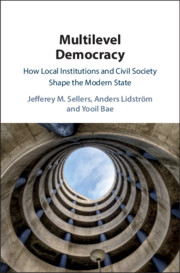Book contents
- Multilevel Democracy
- Multilevel Democracy
- Copyright page
- Epigraph
- Contents
- Figures
- Tables
- Acknowledgements
- Note on the Text
- 1 Introduction
- 2 Multilevel Democracy and the Modern State
- 3 Multilevel Democracies
- 4 Trajectories of Local State Formation
- 5 The Local State and the Formation of Civil Society
- 6 The Policy State and Local Governance
- 7 The Quality of Multilevel Democracy
- Postscript
- Appendix Cluster Analysis of Institutional Indicators
- References
- Index
6 - The Policy State and Local Governance
Published online by Cambridge University Press: 11 February 2020
- Multilevel Democracy
- Multilevel Democracy
- Copyright page
- Epigraph
- Contents
- Figures
- Tables
- Acknowledgements
- Note on the Text
- 1 Introduction
- 2 Multilevel Democracy and the Modern State
- 3 Multilevel Democracies
- 4 Trajectories of Local State Formation
- 5 The Local State and the Formation of Civil Society
- 6 The Policy State and Local Governance
- 7 The Quality of Multilevel Democracy
- Postscript
- Appendix Cluster Analysis of Institutional Indicators
- References
- Index
Summary
The final stage in the elaboration of contemporary infrastructures for multilevel local governance was a wider transformation in the tasks and operation of the state. In a vast range of domains, new institutions established the development and pursuit of specific collective aims, or public policies, as a defining feature of public life. On top of constitutional hierarchies among governments, and the general features of administrative capacity linked to national bureaucracies, new layers of policymaking institutions introduced rules and procedures that reordered relationships among governments as well as between the state and society. The growth of the welfare state has been perhaps the most studied of these developments. The emergence of social policy created new domains of state activity from education to health to social insurance. These were only a part of an even wider expansion of public policy throughout society, to consumer protection, economic development, economic regulation, and environmental quality. Even policies that were already a feature of early states, such as policing and emergency services, became regularized and professionalized.
- Type
- Chapter
- Information
- Multilevel DemocracyHow Local Institutions and Civil Society Shape the Modern State, pp. 261 - 308Publisher: Cambridge University PressPrint publication year: 2020

